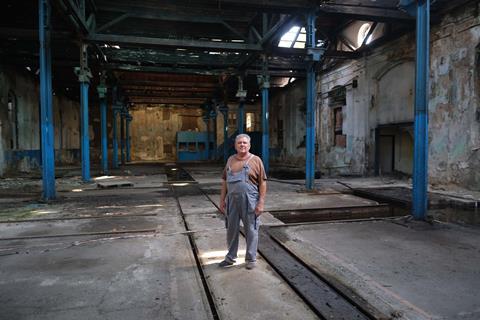Godan Devic continues his work documenting Croatia’s difficult transition to capitalism through the bankruptcy of a rolling stock company

Dir/scr: Goran Devic. Croatia. 2023. 79 mins.
The painful aftershocks of Croatia’s transition to 21st-century capitalism reverberate through What’s To Be Done?, the latest documentary by writer-director Goran Devic’s to chronicle his country’s socio-economic situation. Adopting an observational style but bearing evident sympathy for his protagonists, Devic traces the impact of a long-established train-factory’s bankruptcy — and eventual closure — on workers and union-officials over the course of a decade. Premiering in Sarajevo’s documentary competition, Devic’s second solo feature-length project will be of interest to festivals and platforms favouring human-rights themes, and with proper handling could enjoy limited theatrical exposure in receptive Balkan markets.
Devic’s exercise in unfussy empathy also has significantly wider implication
Having focused on the provincial city of Sisak for On the Water (2018) and mid-lengthers Steel Mill Caffe (2017) and The Building (2022), Devic — still best known for hisintense war-drama The Blacks (2011), co-directed with Zvonimir Juric — now switches his attention to the capital, Zagreb. Founded in 1894 in the heart of the sprawling Austro-Hungarian empire, the Gredelj rolling-stock company still employed thousands well into the current century. The wheels only really started to come off the wagon after the 2008 global crisis, amid cuts in state-expenditure under right-wing Croatian PM Ivo Sanader — who is currently serving an eight-year jail sentence for corruption.
Following an enigmatic prologue in which workers contemplate a mural of long-gone Yugoslavian state-company logos, Devic takes up the story in September 2012 — immediately after the shockingly unexpected suicide of stressed-out deputy union-leader Mladen Mladenovic. Mladenovic and his superior Zelko Starcevic had been involved in stormy discussions with Gredelj management over the very late payment of the staff’s wages, harbinger of more drastic problems just around the corner.
The crux of the film’s narrative is the bankruptcy order imposed in late 2012, fiercely opposed by Starcevic’s union and even attacked as potentially illegal. Devic and editor Iva Kraljevic divide up the following decade into chapters heralded by title-cards indicating how much time has passed since the winding-up order was announced — an unnecessarily fiddly way of marking chronology. For the first 50 minutes the focus is mainly on Starcevic, a dyspeptic and doggedly driven fellow though perhaps not quite sufficiently compelling to be the main protagonist of a documentary.
Devic adopts familiar fly-on-the-wall methods for most of the running-time, but then with about 25 minutes remaining he includes a lengthy sequence in which the assembled workers (including Starcevic) watch a rough-cut of the film so far. Their emotional response during the screening (when they are silent) and immediately afterwards (when they are very vocal) makes this the strongest section of What’s To Be Done?. Here Devic persuasively illustrates the human costs of 21st century neoliberalism, globalisation and privatisation — and how utterly they contrast with the chummy, clannish Balkan workplace cultures upon which Yugoslavia depended (and which are still widely found across the region.)
An invaluable microcosm of what happened to so many organisations that prospered in the Yugoslavian days only to messily collapse in the wake of the federation’s downfall, Devic’s exercise in unfussy empathy also has significantly wider implications. His choice of title of course places his film in an illustrious lineage that includes works by Lenin (1902) Tolstoy (1886) and the 1863 novel by Nikolay Chernyshevsky which inspired them both — all named in reference to John the Baptist’s redistributionist ethos as described by St Luke.
In terms of creative ambition and potential practical impact, Devic isn’t really operating in the same league as those Russian antecedents, needless to say. His most audacious gambit is a performance-art-style coda in which some of the workers mutely mime their assembly-line routines in the crumbling shell of the dilapidated factory. This wordless epilogue is elegiac and even touching, but sits incongruously alongside the more straightforwardly verité material that precedes it.
With such a relatively brief duration, Devic and company might more profitably taken the time to sketch the wider contexts in greater detail. As it is, the film ends with no concrete sense of who teh “real culprits” mentioned early on actually are — they remain shadowy entities, blithely destroying companies and lives before moving on to the next target.
Production company/international sales: Petnaesta umjetnost (15th Art Productions), 15art@15art.hr
Producer: Hrvoje Osvadic
Cinematography: Damian Nenadic
Editing: Iva Kraljev























